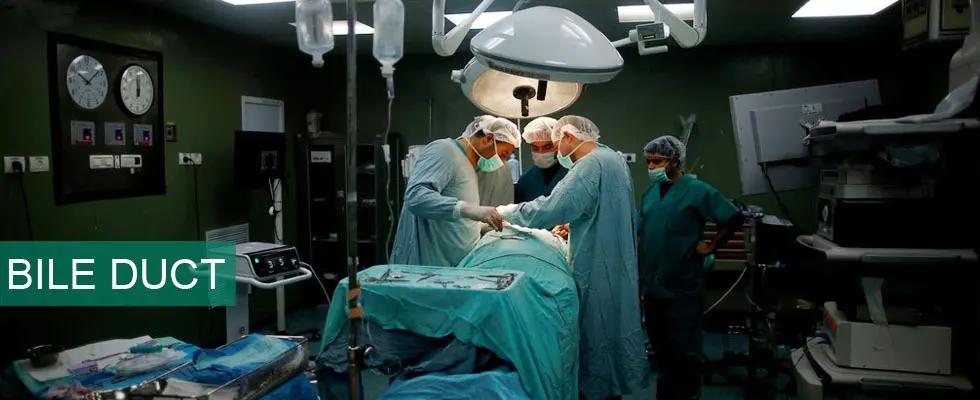Call Now:
+91 93308 06699 (Argha - Secretary)
Dr. Suddhasattwa Sen
Bile Duct Cancer Surgeon in Kolkata, West Bengal
MBBS (Gold medalist), MS (Gold medalist), DNB (All India Gold medalist), MNAMS (IND), MRCS (UK), FICS (USA), DNB (SGE & HPB), FMAS (AMASI), Fellow HPB & Liver Transplant (Sir Gangaram, Apollo, Del), CC Lap Solid Organ Surgery (Ethicon), CC Endohernia (Ethicon), CC Lap Colorectal (Galaxy, Pune) / Lap UGI surgery and VATS (Calicut), OB. Fellow HPB & GIS (SGPGIMS, Lucknow / GB Pant, Del).
Sr. Consultant and Former Head of Dept. Dept of GI HPB Surgery and GI HPB Oncosurgery, AMRI Hospital, Dhakuria, Kolkata.
Jt Director & Sr. Consultant || GI HPB and GS Dept || Medica Superspecialty Hospital, Kolkata (Former)
Formerly Sr. Consultant Apollo Gleneagles, Fortis Kolkata, Belle Vue Kolkata, CMRI, Woodlands, EEDF & SASK.
Bile Duct
BILE DUCT DISEASES
• Gallstones
• Acalculous Cholecystitis
• Cancer
• Torsion
• Bleed
• Jaundice
• Empyema
• Mucocele
• Fistula to organs
• Mirizzi Syndrome
• Choledochal Cyst
• Stones
• Biliary Stricture
• Biliary cancer
• Biliary worms
SURGERIES
• Lap or open cholcystectomy
• Lap or open cholecystostomy
• Radical cholecystectomy
• Biliary Resection
• Biliary Bypass
• Choledochal cyst excision
• Ercp etc
Surgery for these cancers requires great skill, as the operation is quite extensive. Usually part of the liver is removed, along with the bile duct, gallbladder, nearby lymph nodes, and sometimes part of the pancreas and small intestine. Then the surgeon connects the remaining ducts to the small intestine.
Surgery for Bile Duct Cancer
There are 2 general types of surgery for bile duct cancer:
• Potentially curative surgery
• Palliative surgery
Potentially curative surgery is used when imaging tests or the results of earlier surgeries show there’s a good chance that the surgeon can remove all of the cancer. Doctors use the term resectable to describe cancers they believe can be removed completely (by potentially curative surgery) and unresectable to describe those they think have spread too far or are in too difficult a place to be entirely removed by surgery. Unfortunately, only a small portion of bile duct cancers are resectable when they are first found.
If potentially curative surgery is being considered, you may want to get a second opinion or even be referred to a large cancer center. Nearly all doctors agree that surgery offers the only realistic chance for curing people with bile duct cancer. But there are differences of opinion about how advanced a bile duct cancer can be and still be treatable with surgery. The surgery needed for bile duct cancer is often complex and requires an experienced surgeon. These operations are most often done at major cancer centers.
Palliative surgery is done to relieve symptoms or treat (or even prevent) complications, such as blockage of the bile ducts. This type of surgery is done when the tumor is too widespread to be removed completely. Palliative surgery is not expected to cure the cancer, but it can sometimes help a person feel better and sometimes can even help them live longer. Palliative surgery is described in more detail in the section “ Palliative therapy for bile duct cancer.”
Surgery to remove bile duct cancer can have serious side effects and, depending on how extensive it is, may require several weeks for recovery. If your cancer is very unlikely to be curable, be sure to carefully weigh the pros and cons of surgery or other treatments that require a lot of recovery time. It’s very important to understand the goal of any surgery for bile duct cancer, what the possible benefits and risks are, and how the surgery is likely to affect your quality of life.
Laparoscopy
If your surgical team is planning curative surgery, they first may do a laparoscopy (a type of minor surgery) to look for any spread of the cancer that could make curative surgery impossible. This procedure is described in the section “ How is bile duct cancer diagnosed?” During the laparoscopy, the surgeon can look for areas of cancer that were not detected with imaging tests. If the cancer is still resectable, laparoscopy can also help plan the operation to remove it.
Surgery for resectable cancers
For resectable cancers, the type of operation depends on the location of the cancer.
Intrahepatic bile duct cancer: These cancers have started in bile ducts within the liver. To treat these cancers, the surgeon cuts out the part of the liver containing the cancer. Removing part of the liver is called a partial hepatectomy. Sometimes this means that a whole lobe (right or left part) of the liver must be removed. This is called hepatic lobectomy. It is a complicated operation and requires an experienced team of surgeons and assistants. If the amount of liver removed is not too great, the liver will still function normally because it has some ability to grow back.
Perihilar bile duct cancer: These cancers begin where the branches of the bile duct first leave the liver. Surgery for these cancers requires great skill, as the operation is quite extensive. Usually part of the liver is removed, along with the bile duct, gallbladder, nearby lymph nodes, and sometimes part of the pancreas and small intestine. Then the surgeon connects the remaining ducts to the small intestine. This is a complex operation that can even have life threatening complications for some patients.
Distal bile duct cancer: These cancers are further down the bile duct near the pancreas and small intestine. Along with the bile duct and nearby lymph nodes, in most cases the surgeon must remove part of the pancreas and small intestine, an operation called a Whipple procedure. Like the other operations, this is a complex procedure that requires an experienced surgical team.
Possible risks and side effects: The risks and side effects of surgery depend on the extent of the operation and a person’s general health. All surgery carries some risk, including the possibility of bleeding, blood clots, infections, complications from anesthesia, pneumonia, and even death in rare cases.
People will have some pain from the incision for some time after the operation, but this can usually be controlled with medicines.
Surgery for bile duct cancer is a major operation that might mean removing parts of several organs. This can significantly affect a person’s recovery and health after the surgery. Serious problems soon after surgery can include bile leakage into the abdomen, infections, and liver failure. Because most of the organs removed are involved in digestion, eating and nutrition problems can be side effects of surgery for this cancer.
About Surgery
Dr Suddhasattwa Sen
MBBS (Gold medalist), MS (Gold medalist), DNB (All India Gold medalist), MNAMS (IND), MRCS (UK), FICS (USA), DNB (SGE & HPB), FMAS (AMASI), Fellow HPB & Liver Transplant (Sir Gangaram, Apollo, Del), CC Lap Solid Organ Surgery (Ethicon), CC Endohernia (Ethicon), CC Lap Colorectal (Galaxy, Pune) / Lap UGI surgery and VATS (Calicut), OB. Fellow HPB & GIS (SGPGIMS, Lucknow / GB Pant, Del).
Contact Number:
+91 93308 06699 (Argha - Secretary)
Email:
drsss_surg@yahoo.co.in
arghamdk@gmail.com
drsen@bestgicancersurgeon.com

